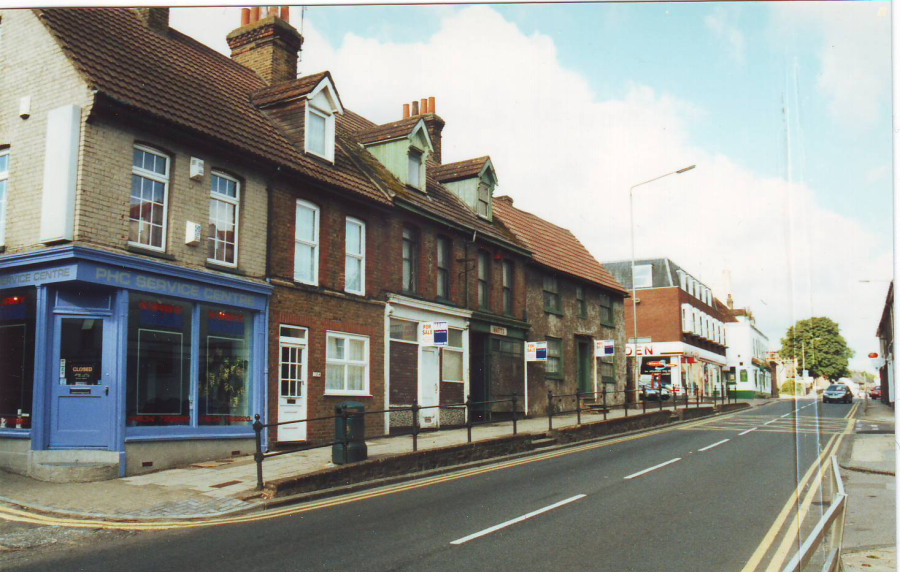WATTS THE CHEMIST , Rainham Kent
Action Forum, July 2002
Among the archives of Watts the Rainham Chemist, whose name can still be read above the boarded-up shop in Rainham High Street, are several books dating back to the mid-nineteenth century. Two contain the notes made by different members of the family as they studied for their pharmacy qualifications. These books both begin with lectures on botany and elementary chemistry, the first page in one case being headed ‘Special Short Notes on Pharmacy. Minor Lecture No. 1’. The lectures, ending with No. 59, are recorded in a soft-back school notebook, but the student’s attention was not always wholly engaged. Beneath the page entitled ‘Lecture 7’, on practical dispensing, is written ‘A lecture far too long, of facts (too) well-known to write’. And inside the back cover the owner has practised the signature ‘R. Watts’ many times. A second, hardback, notebook which is un-named has similar notes on the sante course of lectures, dated 1885, and also includes ‘Practical Notes on Photography’.
Robert Watts was the nephew of Henry Watts, a widower, who had been in business as Chemist and Druggist in Chatham High Street from the mid-nineteenth century. In 1881 Henry had two apprentices, Robert, aged 17, and Frank Dixon, who was 16. Robert stayed with his uncle at the shop near the bottom of Hamond Hill for at least ten years. but by 1899 he had taken over the premises of George Andrew, Chemist and Druggist. They were at No. 126 High Street, Rainham, next to the ‘Waterman’s Arms’, and opposite Ivy Street. For many years a gas lamp standard, with ‘Watts Chemist’ painted on the glass enclosing the light, stood outside. During the early part of the twentieth century Watts also acted as an insurance agent. The heading of a partly-used duplicate book makes it clear that he was now fully qualified: ‘Robert Watts, Dispensing Chemist (by examination)’.
Of more general interest are two volumes in which have been collected recipes for the wide variety of products sold by a Victorian chemist — not just medicines, but ink, fly glue, hair pomades and tonics, ginger beer and lemonade, label varnish, curry powder, Nubian blacking and lavender water. Many of these have been cut from papers and stuck in, others are hand-written. Some have been crossed through, perhaps because a more effective ‘chilblain specific’ or ‘remedy for warts’ has emerged. Medicines for sick dogs, sheep, cows and horses play a significant part. The earliest note dates from 1842, but other hands have continued the collection beyond 1880.
Photo of Watts the Chemist shop in 2001 (centre of the shot with red WATTS on green sign)
This ‘Cure for the Ague’ is never known to fail if taken regularly:
Powder bark
Ground black pepper
Salt
Tartar
Snake root powder
Poppy syrup
Treacle sufficient to form an electualy.
This was to be taken every four hours ‘when the fit is oft’. The compiler remarks that for ‘wealdy wemen and children’ the snake root should be omitted. Also preserved is a counter prescription book, which opens in August 1900, from the Rainham shop At the front is an index of account customers, with details of the medicines which were frequently required by them. Then begins the record of what was dispensed each day, occasionally with marginal notes — ‘heart shaky’; ‘tuberculous glands’; ‘slight sunstroke’. By 1912 prices are sometimes added: 1/-was standard. After this date the book has been used only intermittently; in 1919, in 1922 for a while, then in 1936. About ten prescriptions were dispensed daily, each transaction carefully numbered.
After the 1950s fewer and fewer medicines were mixed on the premises, and the prescriptions read ‘tabs’ of branded products, such as ‘Dequadin loz(enges)’. From 1960 the inclusion of the name of the doctor becomes more frequent, and when the record ends in the early seventies, by which time perhaps 50% of all prescriptions are for ‘the pill’, it is always noted.
According to a street directory of 1954/5 there were by then two other Chemists in Rainham, Fenwick’s at 31 London Road and Hickmott’s at 85 London Road, while Watts remained at the original site. The section of the A2 known as London Road at that time extended as far as ‘The Cricketers’. Watts the Chemist finally closed about twenty years ago, as the trading centre of Rainham moved west and other pharmacies, closer to doctors’ surgeries, flourished.
RAD
















































































